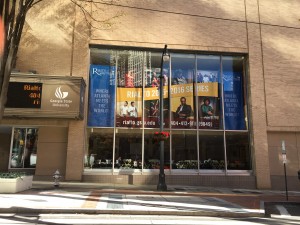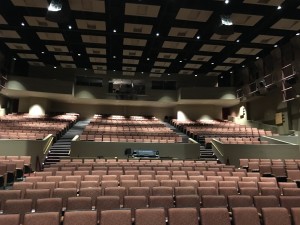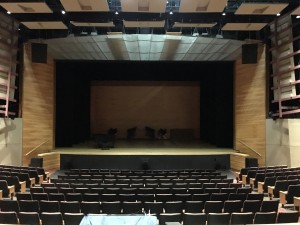Hello fellow theater lovers! My name is Allison, and I live in Atlanta Georgia which is home to the Georgia State University campus, where I am currently studying history. Atlanta has been known as a home for the many beautiful theaters such as the Fox Theater as well as the Loew’s Grand Theater (which unfortunately is no longer a standing theater). My personal favorite theater is located right on the Georgia State Campus known as the Rialto Center for the Arts. I fell in love with the Rialto after going to a few of my school of music friends recitals. I wanted to further my knowledge in the history of this astonishing theater. The Rialto was a wonderful location to research and I hope you enjoy learning about this location as much as I did.
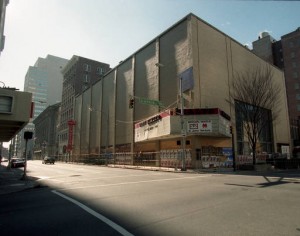
source: “Renovation of the Rialto Theater by Georgia State University, 1995 “AJCNL 1995-02-20B, Atlanta Journal-Constitution Photographic Archives. Special Collections and Archives (Georgia: Georgia State University Library, 1995)
The year was 1916, when Rialto opened its doors for the first time as one of the largest movie houses in Atlanta, holding up to 925 people.[1] The theater was named the Rialto (meaning Marketplace) due to the location of the theater which was in the Central Business district and the original theater district of Atlanta.[2] Movie ambassadors all over the Metro Atlanta area gathered to partake in popcorn stuffing and friendly laughter as they enjoyed their film of choice. In which these movie goers were extremely pleased to discover that the first motion picture to hit the Rialto movie screen was “Gloria’s Romance,” starring Billie Burke.[3] Not only did the movies bring in attraction but over this marquee was the largest electric sign south of New York City veritable spectacular in its day presenting a glittering sunburst effect.[4] Once you look past the electric sign there stands the extravagant box off located on the left side of the theater. [5] The Rialto became more than just a theater, it became the center for hope and good times as the Great Depression made a grand appearances for the Struggling American. As the theater doors remained open though out the entire Great Depression, the Atlantans used the theater as an escape from reality.
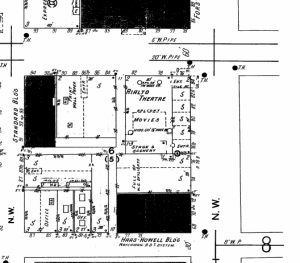
Sanborn map from 1931-1932 of the Rialto’s location between Luckie St. and Forsyth St.
Source: corner of Luckie St and Forsyth St, Atlanta, Sheet 7, Sanborn fire insurance map.
Until the operation of the theater was to be interrupted by the rapidly escalating population and the needs of Atlanta, and in 1962 the theater was torn down to make way for a 1200 seated Rialto Movie House.[6] There were two movie houses, the Rialto Theater and the Central Theater, that was looked upon by the Martin Theater chain (based in Columbus) to invest in.[7] Both of these movie houses were owned by an independent, in which were apart of a 10-year deal.[8] In 1954, Martins Theater chain bought the two Atlanta Theaters from Charles Mion, the purchase prices was reported to be around $250,000.[9] Surpiseingly the remodeling of the Riatlo was the first downtown theater in a decade to hold this construction permit.[10] After everything had been set in stone it was time to get to work! Over the upcoming year new additions to the Rialto Theater will help draw in more business. By adding in enormous window, more than over 30 feet high on the Luckie street side of the building, it will expose the theater lobby and public levels.[11]
The building will also gain a beautiful staircase that will have a new type of glass siding, the first to be used in a building during this area. [12] The monumental style stair case will lead up to the theater level where movie goers will enter and hunt down a cozy spot.[13] In addition to all the new lovely features the Rialto will welcomed a new screen which will be fifty-eight feet wide and twenty-six feet tall, at this point the Rialto will have the second largest screen in town (the Fox Theater takes the gold metal for the largest theater).[14] Opening day could not come soon enough for the city of Atlanta but thankfully the brand new Rialto reopened in 1963. Not only did the new theater hold plays and musical events but it also was rented out to other activities. One activity that took place in the theater was a self defense and martial arts classes. A newspaper article advertised that millions of Americans who suffer from being hit in the kisser by your husband or getting chased by a frying pan by your wife should go the extra mile and learn how to fight.[15] Unfortunately, the New Rialto’s life was short lived. After thirty wonderful years the well known Theater had to close there doors once more due to a decline in the down town economy in 1869.[16] The Theater remind closed until the year 1991, when a real estate consultant, David Haddow, approached the school of music director, Dr. Richard Koehler, about relocation the School of Music to one of the several vacant buildings in the block bounded by Forsyth and Luckie.[17] This was a huge opportunity for Georgia State University, not only was it a major cultural contribution to the city with a first-class performance hall as well as the university could further weave itself into downtown Atlanta.[18] A couple phone calls here and there and like magic the school was able to run a fund-raising campaign that would allow them to raise $14 million dollars into bringing the Rialto back to life.[19] This campaign was led by Georgia State University president Carl V. Patton and A.W. “Bill” Dahlberg.[20] Construction for the project began in fall of 1994, new additions such as a new roof that has been raised 12 feet, a larger lobby, indoor box office, a new stage, an orchestra pit, and last but not least 833 new comfortable seating arrangement, were added.[21]
After many years of hard work in recreating the “new” “new” Theater, The fabulous Rialto opened its doors yet again in March 1996.[22] This grand opening became an even greater deal to the 400 music majors and the twenty-eight full-time and thirty-nine part-time faculty members eagerly wanting to perform their work in the finest medium-sized concert halls in the area.[23] The Rialto Center for the Arts has embraced a long history of “costume changes.” In which many have brought hardship yet the beautiful city of Atlanta was never ready to give up this breath taking theater. Thankful, the Rialto is still running on a day to day basics under the hands of Georgia State University. As you embark your journey to this lovely Theater make sure you take note to all the beautiful qualities the theater holds.
[1] “Rialto Center for the Arts: History.” Georgia State University, accessed November 25, 2016, http://rialto.gsu.edu/about/history-2/
[2] “Rialto Center for the Arts: History.”
[3] Lucchese, Sam F. “Tonight’s close marks end of the 46-year Rialto Theater.” The Atlanta Construction, September 9, 1962, 9D.
[4] Lucchese, Sam F. “Tonight’s close marks end of the 46-year Rialto Theater.”
[5] Darmody, Steve. “Rialto Center of the Arts,” Morning song concert, accessed on November 25, 2015.
[6] Simmons, Erin Aubrey. “Campus Expansion though Historic Preservation and Adaptive Reuse,” (Master Thesis, University of Georgia, 2003): 35.
[7] “Two Theaters solds; Rialto and Cental,” The Atlanta Constitution (1946-1984), Augest 1, 1961. 14.
[8] “Two Theaters solds; Rialto and Cental,” The Atlanta Constitution.
[9] “Two Theaters solds; Rialto and Cental,” The Atlanta Constitution.
[10] Martin, Harold H. “Atlanta an Environs: A Chronicle of its people and events 1940-1970,” Volume III. Georgia: The Atlanta History Center, 1987. Google Books. 353.
[11] Erwin, George. “ Rialto Theater Building Due for Demolition.” The Atlanta Constitution, July 15, 1962. 10.
[12] Erwin, George. “ Rialto Theater Building Due for Demolition.”
[13] Erwin, George. “ Rialto Theater Building Due for Demolition.”
[14] “Fabulous Rialto Opens Thrusday” The Atlant Constitution, July 8, 1963. 3A.
[15] Byrd, Williams. “Rialto theater the martial arts of film,” Atlanta Daily World. October 1, 1982. 3.
[16] “Rialto Center for the Arts: History.”
[17] “Rialto Center for the Arts: History.”
[18] “Rialto Center for the Arts: History.”
[19] “Rialto Center for the Arts: History.”
[20] “Rialto Center for the Arts: History.”
[21] “Rialto Center for the Arts: History.”
[22] “Rialto Center for the Arts: History.”
[23] Orr, N. Lee. “Classical Music in Atlanta,” New Goerogia Encylopedia, November 14, 2013. Google Books. Web access December 1st 2015.

